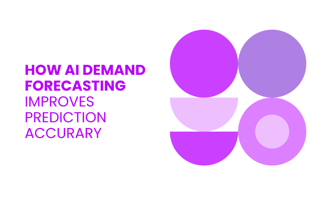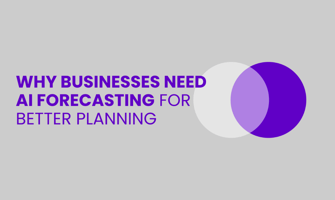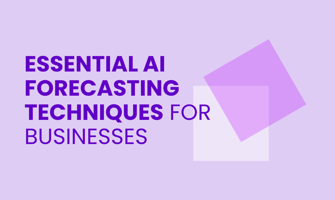Unreliable demand forecasts lead to lost sales, wasted inventory, and poor customer experience....
Key Features of AI Forecasting Tools and How They Work
Every business faces uncertainty—market trends shift, customer demand changes, and unexpected risks arise. Making the wrong decision can lead to lost revenue and missed opportunities.
AI forecasting tools help businesses stay ahead by predicting trends, demand, and risks with better accuracy. They analyze large amounts of data, spot patterns, and make predictions faster than traditional methods. Companies in finance, healthcare, retail, and other industries rely on them to make smarter decisions.
But how do these tools work, and what makes them effective? This article breaks down their key features and explains how they improve prediction accuracy across different industries.
Want to understand AI forecasting better? Read our article, "Why Businesses Need AI Forecasting for Better Planning."
Importance of AI Forecasting Tools in Business Operations
AI forecasting tools help businesses make better decisions by turning large amounts of data into useful insights. Instead of relying on guesswork, these tools analyze historical data, detect patterns, and generate predictions. This reduces uncertainty and allows companies to plan strategically.
These tools also improve operational efficiency by automating complex analysis. Instead of manually sifting through data, businesses can use AI to identify trends and optimize resources. Key benefits include:
Improved resource allocation – AI forecasting helps businesses determine the right amount of inventory, staffing, and budget allocation based on projected demand.
Faster decision-making – AI models process data in real time, allowing companies to respond quickly to market changes.
Reduced waste and costs – More accurate predictions help businesses minimize overproduction, excess inventory, and unnecessary expenses.
Enhanced risk management – AI tools assess potential risks by simulating different scenarios, helping businesses prepare for uncertainties.
Key Features of AI Forecasting Tools
1. Advanced Data Processing and Integration
AI forecasting tools process large amounts of data from different sources to improve prediction accuracy. They collect and combine structured and unstructured data, such as historical records, market trends, weather conditions, and customer behavior.
By integrating these diverse datasets, AI models create a more complete and reliable foundation for forecasting.
To make sense of this data, AI tools use machine learning techniques to detect trends and patterns. These tools apply algorithms that analyze past data and recognize relationships between variables.
As the system processes more information over time, it refines its understanding of data patterns and improves forecasting precision.
For businesses looking to implement AI forecasting, proper data integration is important. Here are key steps to ensure effective data processing:
Standardize Data Formats – Ensure that data from various sources follows a consistent structure to avoid errors in analysis.
Eliminate Duplicate or Incomplete Data – Clean datasets by removing redundancies and filling in missing values to improve model accuracy.
Use Real-Time Data Feeds – Incorporate up-to-date information to adjust forecasts dynamically as new data becomes available.
Utilize Cloud-Based Storage – Store large datasets in scalable cloud environments to support efficient processing and analysis.
2. Machine Learning Algorithms for Pattern Recognition
Machine learning algorithms allow AI forecasting tools to recognize patterns in data that might be difficult for humans to detect. These algorithms process vast amounts of information, identifying trends and relationships that improve prediction accuracy.
By analyzing historical data, machine learning models learn how different variables interact, helping businesses make more informed decisions.
AI forecasting tools automatically select and optimize models based on the data they receive. Instead of relying on a single model, they evaluate different approaches to find the most effective one.
This reduces the need for manual adjustments and ensures forecasts remain accurate as new data becomes available. Key techniques used in AI forecasting include:
Neural Networks – These models mimic the human brain, recognizing complex patterns in data and improving over time as they process more information.
Decision Trees – These models break down data into smaller segments, identifying key factors that influence predictions.
Regression Models – These statistical techniques analyze relationships between variables, estimating future trends based on past data.
Time Series Models – These models focus on sequential data, capturing seasonal patterns and long-term trends.
To improve accuracy, AI forecasting tools continuously refine their models. They incorporate new data, detect shifts in trends, and adjust predictions accordingly. This adaptability makes AI-driven forecasting more reliable than traditional methods, which often require manual updates and assumptions about future conditions.
3. Automated Model Selection and Optimization
AI forecasting tools automate the process of selecting the best predictive models, reducing the need for manual trial and error. Instead of requiring users to test multiple forecasting methods, these tools analyze historical data, evaluate different models, and choose the one that delivers the most accurate predictions. This automation improves both efficiency and reliability in forecasting.
Platforms like 180ops take this further by integrating real-time data and AI-driven insights to refine sales forecasting and revenue predictions. By automating model selection and optimization, businesses can reduce uncertainty and make data-backed decisions faster.
To optimize model selection, AI forecasting tools use machine learning techniques such as:
Ensemble Learning – Combines multiple models to improve accuracy by averaging or weighing their outputs.
Hyperparameter Tuning – Adjusts key model parameters to improve performance without manual intervention.
Automated Feature Selection – Identifies the most relevant variables, preventing unnecessary inputs from reducing accuracy.
4. Scenario Analysis and Risk Assessment
To conduct scenario analysis, AI forecasting tools create various "what-if" models based on different assumptions. These models help businesses plan for situations such as:
Demand fluctuations – Predict how changes in consumer behavior or market conditions affect sales and inventory.
Economic downturns – Assess how recessions or inflation impact revenue and operational costs.
Supply chain disruptions – Identify the potential effects of supplier delays, geopolitical events, or raw material shortages.
Regulatory changes – Understand how new policies or legal requirements influence financial performance.
AI forecasting tools also quantify risks by assigning probabilities to different outcomes. This allows businesses to prioritize strategies based on the likelihood and impact of various risks.
For example, a company can allocate resources to mitigate the most probable disruptions while maintaining flexibility for less likely events.
To implement effective scenario analysis, businesses should:
Define key variables – Identify the internal and external factors that influence forecasts, such as market demand, competitor actions, or economic indicators.
Test multiple scenarios – Run simulations for different possibilities, including best-case, worst-case, and moderate situations.
Update models with new data – Continuously refine forecasts using the latest market trends and business performance metrics.
5. Explainability and Transparency
AI forecasting tools have to be explainable and transparent to ensure trust and usability. When businesses rely on these tools for decision-making, they need to understand how predictions are generated. Without transparency, users might struggle to validate forecasts or identify potential biases in the data.
Explainability helps users interpret AI-generated predictions by showing the factors influencing the forecast. This can include:
Feature importance scores – Indicating which data inputs contribute most to the prediction.
Model decision pathways – Explaining how the model processes data to reach conclusions.
Confidence intervals – Providing a range of possible outcomes to reflect uncertainty.
Audit trails – Allowing users to track how predictions change over time.
Transparency is also critical for regulatory compliance, particularly in industries like finance and healthcare, where decision-making has to be justified. To improve transparency, businesses can:
Use AI models with built-in explainability features, such as decision trees or SHAP (Shapley Additive Explanations).
Implement dashboards that visualize how forecasts are generated.
Regularly validate AI predictions against real-world outcomes.
How AI Forecasting Tools Work
1. Data Collection and Preprocessing
AI forecasting tools start with collecting raw data from multiple sources, but this data is often incomplete, inconsistent, or noisy. To ensure accuracy, preprocessing techniques refine the data before analysis. These techniques include:
Handling missing values by filling gaps with estimated values based on historical patterns or removing incomplete records when necessary.
Removing noise such as duplicate entries, outliers, or irrelevant data points that could distort predictions.
Standardizing formats to ensure consistency across different data sources, makes it easier for AI models to process information efficiently.
Effective preprocessing improves model performance by ensuring that only clean, structured data enters the forecasting system.
Businesses implementing AI forecasting tools should invest in robust data management practices, including automated data validation and cleansing pipelines. This reduces errors and improves prediction accuracy over time.
2. Feature Engineering and Model Training
Model training relies on historical data to teach AI forecasting tools how to recognize patterns and make accurate predictions. The process begins by feeding large datasets into machine learning models, allowing them to analyze past trends and relationships. These models then adjust their internal parameters to minimize prediction errors, improving their accuracy over time.
To improve forecasting precision, AI tools use feature engineering to identify the most relevant data points. This involves selecting key variables—such as stock prices, interest rates, or market sentiment—that influence financial trends.
By refining the input data, AI models can focus on the most impactful factors, leading to better predictions. The model training process follows a structured approach:
Data Splitting: The dataset is divided into training and testing sets. The training set helps the model learn patterns, while the testing set evaluates its performance.
Algorithm Selection: AI tools choose from various machine learning algorithms, such as neural networks or decision trees, depending on the complexity of the forecasting task.
Model Evaluation: Performance metrics like mean absolute error (MAE) and root mean square error (RMSE) are used to measure accuracy. If the model performs poorly, adjustments are made to improve it.
Continuous Learning: As new data becomes available, the model updates itself to stay relevant. This ensures forecasts remain reliable even as market conditions change.
For financial forecasting, well-trained AI models help predict stock market trends and assess investment risks. By continuously refining their predictions, these tools enable businesses to make data-driven decisions, reducing uncertainty and improving financial planning.
3. Prediction Generation and Continuous Improvement
AI forecasting tools generate predictions by analyzing historical data, identifying patterns, and applying trained models to new inputs. Their predictive accuracy improves through continuous learning mechanisms, which allow models to refine their outputs based on new data and feedback loops.
When new data becomes available, AI models update their parameters to reflect recent trends. This helps businesses make more accurate forecasts, especially in dynamic industries like supply chain management, where demand shifts frequently.
Feedback loops further improve AI models by assessing past predictions and adjusting future outputs accordingly. This reduces errors and improves decision-making over time.
To implement AI-driven continuous improvement in forecasting:
Integrate real-time data sources: Ensuring that the AI model receives up-to-date information, such as sales trends, market conditions, or external factors like weather, improves prediction accuracy.
Monitor model performance: Regularly evaluating forecast accuracy helps identify discrepancies and informs necessary adjustments.
Fine-tune model parameters: Adjusting hyperparameters, retraining models with fresh data, and utilizing automated model selection improve overall reliability.
Implement feedback mechanisms: Comparing actual outcomes with forecasts allows AI models to learn from mistakes and refine future predictions.
How AI Forecasting Tools Improve Prediction Accuracy Across Industries
1. Finance: Stock Market Predictions and Risk Assessments
AI forecasting tools improve stock market predictions by analyzing large datasets, including historical prices, economic indicators, and news sentiment. They detect hidden patterns and correlations that human analysts might overlook, leading to more informed investment decisions. These models continuously learn from new data, improving accuracy over time.
Another advantage is real-time market signal detection. AI tools monitor financial reports, interest rate changes, and geopolitical events, assessing their impact on stock prices. This helps investors respond quickly to market shifts, minimizing risks and maximizing returns.
For effective implementation, businesses need diverse data sources, the right AI models, and continuous monitoring. Using regression models, neural networks, and reinforcement learning techniques ensures accurate predictions, while regular updates enhance model performance in changing market conditions.
2. Supply Chain: Demand Forecasting and Inventory Optimization
AI forecasting tools enhance demand prediction by analyzing sales history, seasonal trends, and external factors like economic shifts and competitor activity. They identify recurring demand cycles, helping businesses maintain the right inventory levels without overstocking or running out of essential products.
By integrating real-time data from multiple sources, AI tools refine demand forecasts and improve supply chain efficiency. This prevents unnecessary storage costs and reduces waste, making inventory management more responsive to actual market demand.
To maximize accuracy, businesses should connect AI forecasting tools with inventory management systems. Continuous data updates help improve predictions, ensuring that companies can quickly adjust stock levels and meet changing consumer needs.
3. Healthcare: Patient Admission Predictions and Resource Planning
AI forecasting tools help hospitals predict patient admission rates, improving resource allocation and staff planning. By analyzing historical admissions, disease trends, and external factors like weather conditions, AI provides hospitals with data-driven insights for better operational management.
These tools allow healthcare providers to adjust staffing levels based on forecasted patient volume. This ensures that enough medical personnel, hospital beds, and essential supplies are available when needed, reducing bottlenecks and improving patient care.
For implementation, hospitals should integrate AI forecasting models with electronic health records and external health trend data. Machine learning algorithms continuously update predictions, helping administrators prepare for seasonal spikes or emergency situations like flu outbreaks.
4. Marketing: Customer Behavior Analysis and Sales Forecasting
AI forecasting tools analyze customer data, including purchase history, browsing behavior, and external market trends, to predict buying patterns. Businesses use these insights to adjust inventory, personalize marketing campaigns, and plan targeted promotions that align with consumer demand.
Customer segmentation is another key benefit. AI groups customers based on shared behaviors, such as frequent purchases or product preferences. This allows marketers to create personalized messages, increasing engagement and conversion rates.
AI-driven pricing strategies further enhance sales forecasting. By analyzing competitor prices, demand fluctuations, and customer willingness to pay, businesses can optimize pricing in real time. This improves revenue while maintaining a competitive edge in the market.
5. Manufacturing: Production Planning and Equipment Maintenance
AI forecasting tools help manufacturers optimize production schedules by predicting demand changes. By analyzing historical sales data, supply chain trends, and market conditions, they provide accurate forecasts, reducing the risk of overproduction or stock shortages.
Predictive maintenance is another major advantage. AI models analyze sensor data from manufacturing equipment, identifying early warning signs of potential failures. This allows manufacturers to schedule maintenance before breakdowns occur, minimizing downtime and repair costs.
For effective integration, manufacturers should connect AI forecasting tools with enterprise resource planning (ERP) systems and IoT sensors. Real-time data flow between forecasting models and production systems ensures more accurate predictions, improving efficiency and cost savings.
Conclusion
AI forecasting tools improve prediction accuracy by processing large datasets, recognizing patterns, and continuously refining models. Their impact spans industries, from finance to healthcare, helping businesses make informed decisions with greater efficiency. As AI technology advances, forecasting tools will become even more precise and adaptable, further improving strategic planning.
AI forecasting tools are transforming how businesses predict trends and optimize decision-making. For B2B companies looking to take forecasting to the next level, 180ops offers a powerful revenue intelligence platform. It integrates AI, machine learning, and real-time analytics to improve sales forecasting, customer insights, and operational efficiency.
By combining internal and external data, 180ops delivers precise revenue predictions and actionable insights, helping businesses drive growth and reduce risks. Contact us now to get started.
FAQ
How Is AI Used in Forecasting?
AI analyzes large datasets, identifies patterns, and makes accurate predictions. It automates data processing, reduces errors, and adapts to market changes.
Which AI Model Is Best for Forecasting?
The best model depends on the use case, with LSTMs for time series, XGBoost for structured data, and transformers for complex patterns. The model choice depends on data quality and forecasting needs.
What Is the AI Tool for Prediction?
AI forecasting tools process data, detect trends and generate predictions. They improve decision-making in finance, healthcare, and supply chains by reducing uncertainty.
What Is the Best Tool for Forecasting?
The best tool depends on your needs, with AI-powered options offering automation, deep learning, and real-time data analysis. Choose based on accuracy and industry requirements.
What Are the Key Features of AI Forecasting Tools?
AI forecasting tools use machine learning, big data, and automation to detect trends. Features include real-time analysis, anomaly detection, and adaptive learning for better accuracy.




